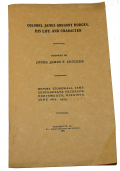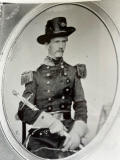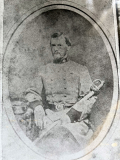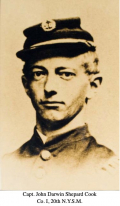site search
online catalog
VIRGINIA OFFICER’S BELT PLATE REMOVED FROM THE BODY OF COL. JAMES G. HODGES, 14th VIRGINIA, KILLED IN PICKETT’S CHARGE, WITH HIS COLONEL’S STARS- THE PLATE RETURNED TO HIS WIDOW IN 1903!
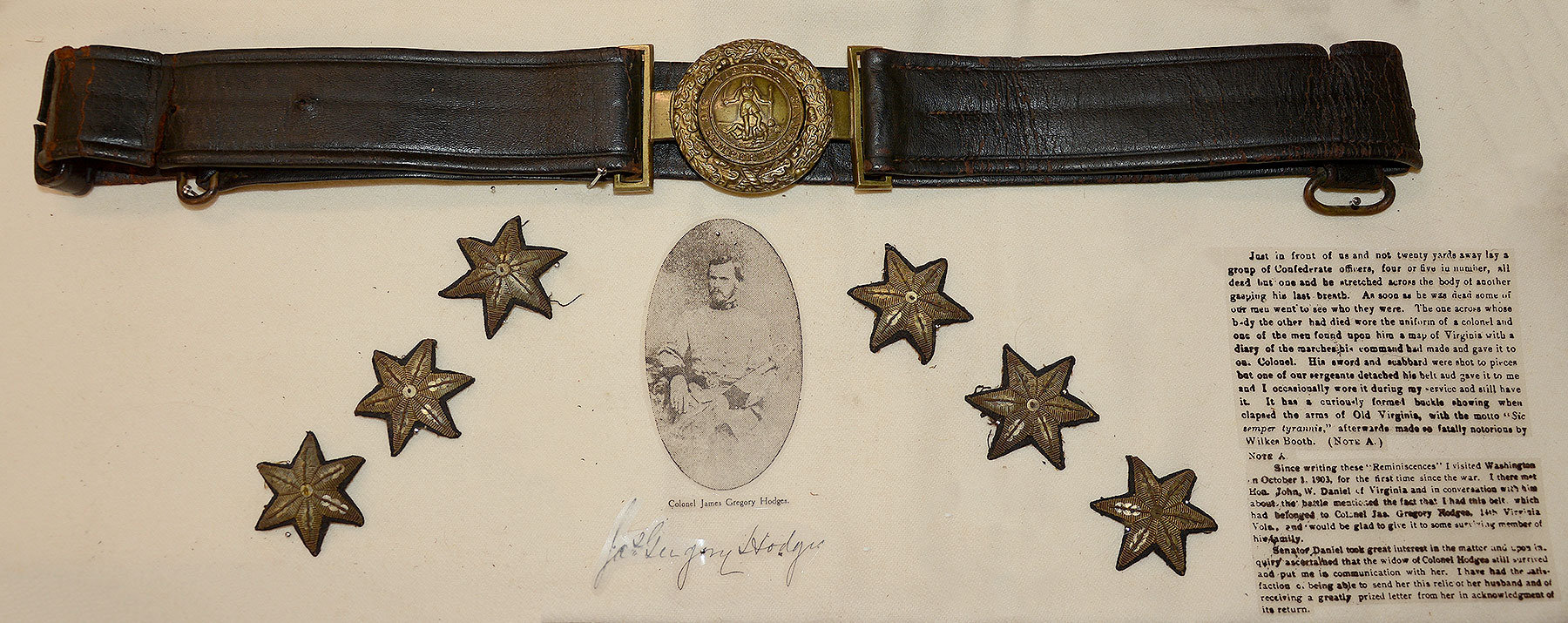
$29,500.00
Quantity Available: 1
Item Code: 846-563
Shipping: Determined by Method & Location of buyer
To Order:
Call 717-334-0347,
Fax 717-334-5016, or E-mail
This historic group includes the Virginia Confederate officer’s sword belt plate removed from the body of Colonel James Gregory Hodges, 14th Virginia, Armistead’s brigade, killed at the stone wall near the 69th Pennsylvania monument and High Water Mark memorial, the climax of Pickett’s Charge, possibly by the last salvo of Cowan’s battery, whose monument states, “Our last charge, double canister, was fired when some of the enemy were over the defences and within ten yards of our guns.” Hodges’s body was among those of “four or five Confederate officers,” with his sword and scabbard, “broken in pieces by a shot,” in the words of the Union officer, Capt. John D. S. Cook of the 80th New York (20th NYSM,) who preserved his swordbelt and returned it to Hodges’s widow in 1903. The family preserved its Virginia beltplate along with six Confederate uniform collar rank stars worn by Hodges as Colonel, all of which came out directly from the family in the 1990s along with two books with his name in them from his personal library.
The provenance is airtight, with all the items coming out of the same Richmond estate sale, held by members of the Baker line of the Hodges family in the early 1990s, with the beltplate and insignia changing hands twice that same day at a Richmond gun show and the third buyer hastening to the sale where he acquired in addition the two books with Hodges’s name in them, supporting the provenance, which was also later firmed up by direct communication with the family.
Supporting documentation with these items includes not only a letter of provenance from the well-known dealer and collector who acquired them on the same day they came out of the family, but also the names of the buyers, biographical and genealogical information, service data on Hodges, etc., and additional material supplied by the family to that third buyer, including a photocopy of the letter sent by the Union officer along with the belt to Hodges’s widow in 1903, copy photos of Hodges in his prewar militia uniform and in his Confederate Colonel’s uniform wearing his swordbelt with this plate, as well as the line of descent of the relics in the family.
At Gettysburg Hodges commanded the 14th Virginia on the right of Armistead’s line, supporting Kemper and Garnett in Pickett’s Charge, losing 250 officers and men in killed, wounded and missing or captured out of 422 on the field. Laino’s Gettysburg Campaign Atlas, Plates 3-52 and 3-53, pages 348 and 349, offers a clear graphic representation of the climactic moments of the fighting as Hodges, seeing a gap in the Union line in front of Cowan’s guns, “urges a number of Rebels hunkered down west of the stone wall to make for the cannons” and Cowan’s five guns “blast them into oblivion.” Close upon this, Harrow’s brigade of Gibbon’s division accompanied by the 80th NY, with Captain Cook, and 151st PA of Biddle’s 1st Corps brigade push north along east side of the stone wall to strike the flank of Confederates who have penetrated the Union line at the Copse of Trees and drive them back or force their surrender, at which point Cook, lightly wounded in the leg, finally had a chance to look around and survey the carnage.
He wrote two similar accounts of how he obtained the swordbelt. One was published in “War Talks in Kansas,” Kansas MOLLUS, Volume 1, pages 321-341, and the other was written soon after that, directly to Hodges’s widow, with whom he had been put in contact by Virginia Senator John W. Daniel, whom he had met by chance on a trip to Washington.
His account to Mrs. Hodges reads: “After the struggle was over, we discovered the bodies of a group of confederate officers just beyond the low stone wall in front of our position. One of them wore the insignia of a Colonel. Some of our men found on his body, a small pocket map of Virginia in which was written his name and rank ‘Jas. Gregory Hodges. Col. 14th Virginia Volunteers.’ This was handed to one of our superior officers. His sword and scabbard were broken in pieces by a shot, but a sergeant of our regiment detached his sword belt and gave it to me. I brought it with me when I removed to the west of the close of the war and I’ve had it here where I have resided for many years.” Cook expressed his sympathy to Mrs. Hodges and his regret at not being able to give any information on Hodges’s place of interment. He also added, “I am glad to be able to send you as I now do the sword belt Col. Hodges was wearing when he fell on that battle field and to assure you by the circumstances I have mentioned that there can be no doubt of the genuiness (sic) of this relic of your gallant husband.”
Cook was a little more graphic in describing the scene for his army comrades:
“The ground near and in front of us was almost literally covered with killed and wounded. Just in front of us and not twenty yards away lay a group of Confederate officers, four or five in number, all dead but one, and he stretched across the body of another, gasping his last breath. As soon as he was dead some of our men went to see who they were. The one across whose body the other had died wore the uniform of a colonel, and one of the men found upon him a map of Virginia with a diary of the marches his command had made, and gave it to our colonel. His sword and scabbard were shot to pieces, but one of our sergeants detached his belt and gave it to me, and I occasionally wore it during my service and still have it. It has a curiously formed buckle, showing when clasped the arms of Old Virginia, with the motto "Sic semper tyrannis," afterwards made so fatally notorious by Wilkes Booth.”
Cook added a footnote to the printed text: “Since writing these ‘Reminiscences’ I visited Washington on October 1,1903, for the first time since the war. I there met Hon. John W. Daniel, of Virginia, and in conversation with him about the battle mentioned the fact that I had this belt, which had belonged to Colonel James Gregory Hodges, 14th Virginia Volunteers, and would be glad to give it to some surviving member of his family. Senator Daniel took great interest in the matter, and upon inquiry ascertained that the widow of Colonel Hodges still survived, and put me in communication with her. I have had the satisfaction of being able to send her this relic of her husband and of receiving a greatly prized letter from her in acknowledgment of its return.” Mrs. Hodges had first written to Cook on October 20, 1903. His response, sent with the belt, is dated Oct. 24.
Of course, it can’t be clear whether Hodges was killed by Cowan’s fire or a bullet from elsewhere. He was lying on the far side of the wall, but Cowan’s monument makes clear that when the guns were fired it was only “some of the enemy” who had crossed the wall and it is telling that Cook refers to Hodges’s sword and scabbard being “broken by a shot” in his letter to Mrs. Hodges. His own recollections of the fighting focus on the fierceness of the infantry combat he was intimately involved in.
Both of Cook’s accounts place Hodges’s body near the monument of the 69th Pennsylvania and the “Highwater Mark” memorial. An account of Cook’s initial meeting with Senator Daniel, published in 1909 by his brother-in-law, J.F. Crocker, former Adjutant of the 9th VA, in “Colonel James Gregory Hodges, His Life and Character,” notes Cook had stated Hodges, “fell at the stone fence, within less than one hundred and fifty feet of the Federal line,” directly in front of the 80th NY, by which he certainly means the regiment’s last position as the fighting ended. Crocker also records that the location had been pointed out to Confederate veterans at the 1887 reunion of Pickett’s veterans at Gettysburg by former Union General Henry Hunt, who had seen Hodges in prewar social functions. On walking over the ground after the fighting ended he noticed Hodges’s body, “. . . thought he had seen the face before, and on inquiry was told it was Col. Hodges of the 14th Virginia.” The identification likely came from Cook or one those standing nearby when Cook found Hodges’s name in his pocket map of Virginia.
The beltplate is complete and in excellent condition. Both tongue are wreath are nicely detailed with an even, medium patina showing a traces of gilt in recesses. The belt loops of both elements are simple rectangles with the bars slightly beveled. The disk is separately stamped and applied to the straight (slight curving, but not stepped) bar and has “VIRGINIA” at top and “SIC SEMPER TYRANNIS” in raised letters on a stippled ground between raised upper and lower border lines around the circumference, and the standing figure with spear and raised sword over the prostrate tyrant, etc., at center. The wreath shows oak leaves and acorns, with a crossed ribbon tie at top and bottom. The back is flat, with no gutter.
On the front side of the upper back plate of the wreath, concealed when the tongue is in place, just above the slot is the maker’s name, “JAMES S SMITH,” the well-known New York maker. The left portion of the name stamp is slightly blurred, but the last four letters of the name are clear and unambiguous, with no alternative candidates. (A short narrow fault or shallow crack in the brass affects the first letter of the last name, but does not show on the reverse.) Smith was making and shipping plates south well into 1861, but the firm name clearly makes this an earlier plate for the Virginia militia. The firm seems to have added “AND SONS” sometime in 1860, dating this plate to 1860 or earlier. We also note that the company’s 1860/61 plates seem to use (or frequently use) a disk with no border lines, a wreath with four ribbon ties, and show a lathe-turned gutter on the reverse. (See Mullinax, O’Donnell & Campbell, and Bazelon on these points.) Hodges’s portrait as commander of the 3rd Virginia, said to be a daguerreotype, shows a uniform coat, sword and belt plate that in style are early1850s, but his Hardee hat would date it more 1858/59, again pushing an 1859/1860 date for the belt plate.
This has been mounted for display on a correct period replacement belt that looks perfect for it in construction and condition. It is fairly plain and looking very much like a Confederate or prewar militia officer’s belt, made of folded black leather, oxidized slightly toward brown, 1-5/8” wide with just an impressed border line running along the top and bottom edge for decoration. There is an oval brass wire loop for suspension of a forward sword sling sewn the bottom edge of the belt on the wearer’s left. The rear sling was probably on a sliding loop, now missing. The belt was adjusted by a narrow oval brass frame and tongue buckle fixed to the other end of the belt, which passes through the belt loop for the tongue portion of the plate. The belt is missing the slings, but retains its sliding tightener, shows some stiffness and cracking, a partial tear through one of the adjusting holes about 6 inches from the plate on the wearer’s right and a few inches beyond that a break, but no missing leather, on what would be the wearer’s right rear. All of this seems perfectly in keeping with Cook’s account of the belt coming off Hodges’s body, his own use of it later, and what the original probably looked like in the hands of the family after it was returned to his widow and deemed not worth preserving, in contrast to the elegant beltplate and embroidered colonel’s stars.
The stars are six-pointed, embroidered gold bullion with sequins on dark blue, about 1-5/8” wide across the points, with black paper backs and showing bits of thread on the reverse indicating they were removed from a uniform likely one left at home or returned to the family from regimental baggage after his death. In size and configuration they match the stars shown on Hodges’s collar in the wartime CDV portrait of him in his Confederate Colonel’s uniform, and one might argue he had worn his best uniform for his portrait. The stars are in excellent condition, showing just expected muting of the gold color from age.
The two books from James G. Hodges’s personal library support the identification and look well as background display for the beltplate and stars. One is Volume 3 of Randall’s “Life of Thomas Jefferson.” The cover is loose, but it displays well opened to show a Portsmouth Library Association label inside and the 1858 signature, “James Gregory Hodges.” The other is Volume 2 of “Lardner’s Lectures on Science and Art,” published in New York in 1846, containing lectures on Atmospheric Electricity, Magnetism, the Steam Engine, and the like. The covers on this, too, are detached, but it is bound in brown leather and has in pencil on the flyleaf, “James G. Hodges, Portsmouth, Virginia,” and the date Oct. 5th, 1846. In addition, Hodges’s name appears also gilt blindstamped on the spine of the book, indicating he had it bound for his library. As books they rate only poor to fair for condition, but they set a moving context for the beltplate and stars as a widow’s mementos of a lost husband and valued family relics displayed in the home.
Hodges was born into a prominent Portsmouth, VA, family Dec. 25, 1828, and educated at “Literary, Scientific and Military Academy of Portsmouth.” He then pursued a medical career, graduating from the University of Pennsylvania, and was praised for his untiring efforts to alleviate the 1855 Yellow Fever epidemic. He also held political and military offices, being elected Mayor in 1856 and again in 1857, and was elected Colonel of the 3rd Virginia Volunteer Militia, six companies, as organized in 1856, later just five. Following Virginia’s passage of an Ordinance of Secession on April 17, 1861, Hodges led the state forces taking possession of the evacuated U.S. Navy Yard at Norfolk on April 21. As a matter of policy in mid-May he was transferred with the other field officers of the regiment to the 14th Virginia, the idea being that discipline might be weak among militia who were neighbors as civilians, and is listed as appointed Colonel of that regiment on May 17, and mustered June 8. He is “present” on all muster rolls until his death at Gettysburg except for Jan. 2-17, 1862, when he is absent with leave at Portsmouth. His widow filed for settlement of his military accounts in December 1863 and in June 1864 received $409.50.
Hodges’s initial posting with the 14th Regiment was to Jamestown Island in late May, where he commanded his own regiment, two additional companies of infantry and several batteries of artillery. He was ordered to the lower Peninsula with six companies in August to join Magruder, and took part in the destruction of the town of Hampton to deny it to Union troops. After a brief posting to Mulberry Island and Lands End, the regiment joined Armistead’s Brigade at Suffolk in May 1862, moving from there to Petersburg and Richmond, where they took part in the Peninsular Campaign. On June 1 Armistead’s brigade, along with Mahone’s, attacked Richardson’s division at Seven Pines. Armistead did not report his losses, but Mahone lost 338, and Armistead’s were likely comparable. At Malvern Hill the brigade was even more heavily engaged, and Hodges reported 12 killed, 57 wounded and 6 missing, about a quarter of his men, coming out with 47 bullet or shot holes in the regiment’s flag, and suffering himself for several hours from the shock of a nearby shell burst that, “knocked me down an burnt all the beard off the right side of my face, scorched the sleeve of my coat from the hand up…”
Hodges commanded the regiment at Second Manassas as part of Anderson’s division under Longstreet and at Antietam, where the brigade supported McLaws in the woods near Dunker Church, he took command of the brigade after Armistead was wounded early in the morning, leading it again at Shepherdstown in covering the retreat on September 19, where one source states the brigade numbered just 60 men. He returned to regimental command at Fredericksburg, where they were not actively engaged, and in Spring 1863 led it during Longstreet’s Suffolk Campaign. The regiment and brigade returned to the main army in June, reaching Gettysburg on July 2 as one of three brigades in Pickett’s division.
The family connection from Hodges to the Baker family, who owned the artifacts, leads through James G. Hodges’s niece, Susan Green Hodges (1862-1891) daughter of his brother William Henry Harrison Hodges (1824-1880,) since both his sons died without issue. She had married William Tilford Baker (1856-1889,) and the artifacts had passed down to his eldest son, then to his eldest son, and finally to his eldest son, who, along with his daughter, liquidated the estate in the 1990s. A number of Hodges family papers are held by Old Dominion University in Norfolk. At the time of the sale of these artifacts the family retained the letter written by Cook, a wartime CDV of Hodges as Colonel, with his sword and wearing what is certainly this belt plate, and a prewar daguerreotype of him in militia uniform, copies of which were provided by the family and included in the research material.
Also included with the group is an original furlough signed by Hodges as Colonel Commanding, datelined, “Headquarters 14” Reg Va Vol / Mulberry Island Sept. 13” 1861.” This is an approval for a 14-day furlough for “Lieut. Kent of Capt. Logan’s Company” recommended by Surgeon E.N. Wood of the 14th. This is not listed among the material acquired at the estate sale or subsequently from the family and is likely a nice association piece added by a subsequent collector.
We find it hard to think of a more historic set than one connected with the climactic moment of the most famous event of the most famous battle of the Civil War. [sr][ph:L]
Extra shipping charge may be required.
~~~~~~~~~~~~~~~~~~~~~~~~~~~~~~~~~~~
THIS ITEM, AS WITH ALL OTHER ITEMS AVAILABLE ON OUR WEB SITE,
MAY BE PURCHASED THROUGH OUR LAYAWAY PROGRAM.
CLICK HERE FOR OUR POLICIES AND TERMS.
THANK YOU!
Inquire About VIRGINIA OFFICER’S BELT PLATE REMOVED FROM THE BODY OF COL. JAMES G. HODGES, 14th VIRGINIA, KILLED IN PICKETT’S CHARGE, WITH HIS COLONEL’S STARS- THE PLATE RETURNED TO HIS WIDOW IN 1903!
For inquiries, please email us at [email protected]
Most Popular
Historical Firearms Stolen From The National Civil War Museum In Harrisburg, Pa »
Theft From Gravesite Of Gen. John Reynolds »
Selection Of Unframed Prints By Don Troiani »
Fine Condition Brass Infantry Bugle Insignia »
British Imported, Confederate Used Bayonet »
Scarce New Model 1865 Sharps Still In Percussion Near Factory New »
featured item
HISTORICAL FIREARMS STOLEN FROM THE NATIONAL CIVIL WAR MUSEUM IN HARRISBURG, PA
Please click on the photograph above to view a flyer containing information regarding a Model 1860 Henry Rifle and pair of cased presentation Colt Revolvers identified to Secretary of War Simon Cameron which were stolen from the museum on February… . Learn More »
site search
Upcoming Events
May 16 - 18: N-SSA Spring Nationals, Fort Shenandoah, Winchester, VA Learn More »















